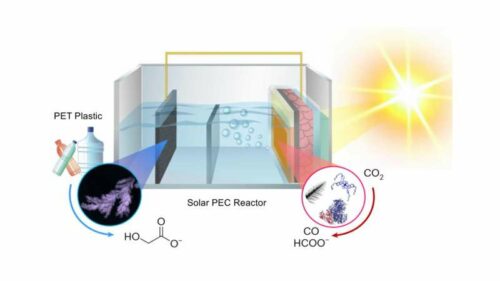Researchers have developed a system that can transform plastic waste and greenhouse gasses into sustainable fuels and other valuable products.

A team of researchers at the University of Cambridge have developed a system that can transform plastic waste and greenhouse gasses into sustainable fuels and other valuable products—using just the energy from the sun. It can convert two waste streams into two chemical products at the same time—the first time this has been achieved in a solar-powered reactor.
This solar-powered reactor converts the carbon dioxide (CO2) and plastics into different products which can be utilized in a variety of industries. Plastic and greenhouse gasses are two major contributors of global warming. Converting these into something more useful with the help of solar energy can be revolutionary. Researchers were able to convert CO2 into syngas, a key building block for sustainable liquid fuels, and plastic bottles were converted into glycolic acid, which is widely used in the cosmetics industry.
Researchers developed an integrated reactor with two separate compartments: one for plastic, and one for greenhouse gases. The reactor uses a light absorber based on perovskite—a promising alternative to silicon for next-generation solar cells.
They also designed different catalysts, which were integrated into the light absorber. Changing the catalyst enabled researchers to then change the end product. Testing the reactor under normal temperature and pressure conditions showed that the reactor could efficiently convert PET plastic bottles and CO2 into different carbon-based fuels such as CO, syngas or formate, in addition to glycolic acid. The Cambridge-developed reactor produced these products at a rate that is also much higher than conventional photocatalytic CO2 reduction processes.
“What’s so special about this system is the versatility and tunability—we’re making fairly simple carbon-based molecules right now, but in future, we could be able to tune the system to make far more complex products, just by changing the catalyst,” said Subhajit Bhattacharjee, the paper’s co-first author.
Researchers : Erwin Reisner, Photoelectrochemical CO2-to-fuel conversion with simultaneous plastic reforming, Nature Synthesis (2023). DOI: 10.1038/s44160-022-00196-0. www.nature.com/articles/s44160-022-00196-0







